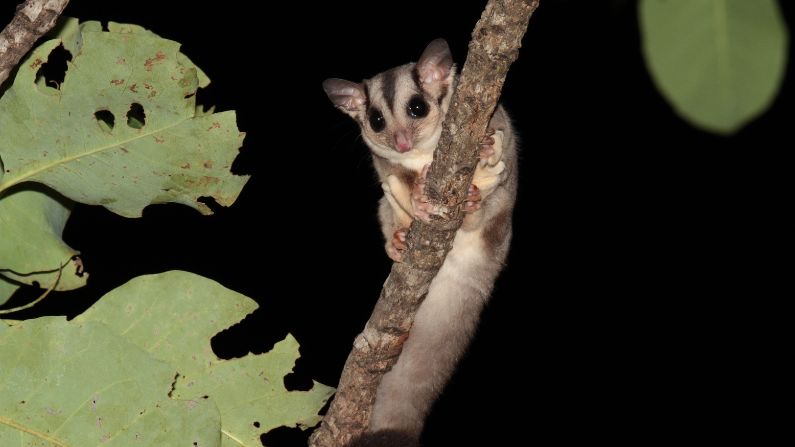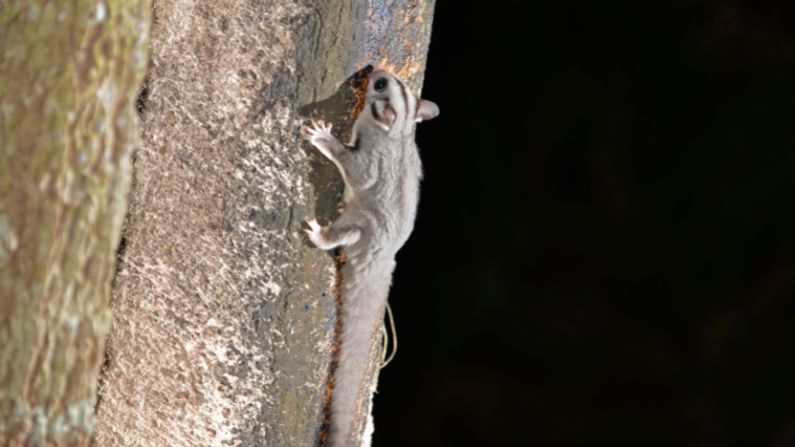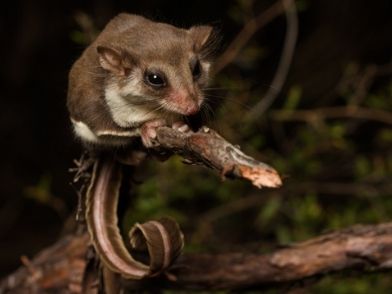Sugar gliders
© Michael J Barritt
Sugar gliders are possibly the most commonly known of all the glider species in Australia. Recent research has shown that gliders previously classified as sugar gliders actually belong to three different species. Like it’s larger cousin, the squirrel glider, sugar gliders can glide up to 90 metres between trees.
Quick facts
COMMON NAME:
Sugar gliders
SCIENTIFIC NAME:
Petaurus breviceps
FAMILY:
Petauridae
QLD CONSERVATION STATUS:
Least Concern
NATIONAL CONSERVATION STATUS:
Not listed
How we help gliders
Through its dedicated Queensland Glider Network, Wildlife Queensland has been educating communities and raising awareness of the importance of gliders and revegetating glider habitat, installing nest boxes in areas where hollow-bearing trees are limited, implementing monitoring programs for local glider populations, and enhancing vital glider habitat.
 © Michael J Barritt
© Michael J Barritt
Did you know?
The sugar glider’s gliding distance is very similar to the squirrel glider as it can also glide up to 90 meters between trees.
 © Canva NFP
© Canva NFP
Threats to sugar gliders
- Feral predators such as cats, foxes, and dogs.
- Habitat clearing.
- Habitat fragmentation.
Previously classified as a single widespread species (Petaurus breviceps), recent research has revealed that the sugar glider is actually three genetically distinct species: Petaurus breviceps and two newly identified species, Krefft’s glider (Petaurus notatus) and the savanna glider (Petaurus ariel).
Home range
- The dominant male marks his territory with saliva and a scent produced by separate glands on his forehead and chest.
- Sugar gliders usually have a home range of about 0.5-7.1 hectares and have a population density of between 0.01-6.1 individuals per hectare.
- Native predators in their range include kookaburras, owls, goannas, snakes, and quolls.
Distribution
When considered as one species, sugar gliders were the most widespread of all the glider species and the most widespread of all arboreal marsupials in Australia. However, the distinction of these three species has resulted in a substantially smaller distribution for the sugar glider and savanna glider.
- The sugar glider’s (Petaurus breviceps) distribution is limited to coastal regions in South-eastern Australia.
- The savanna glider (Petaurus ariel) lives in the tropical woodlands of northern Australia, where its range has contracted by 33% since the early 1990s.
- The Krefft’s glider (Petaurus notatus) is found on the western side of the Great Dividing Range from South Australia to South East Queensland and coastally from South East Queensland to Cape York. It was introduced into Tasmania in 1835 and occurs in New Guinea and other various neighbouring islands.
Description
The sugar glider’s fur is a blue-grey to brown-grey above with a dark stripe that extends from the middle of the head to the mid-back region. The tail can have a white tip whereas the squirrel glider never has a white tip. The face of the sugar gliders is blunter than the squirrel glider as well.
The gliders are about the size of a rat, and the tail is about the thickness of a human thumb and is slimmer than the squirrel glider.
Body measurements:
- Head-body length, 160-210 averaging 170 mm
- Tail length, 165-210 averaging 190 mm
- Weight, males 115-160 averaging 140 grams, females 95-135 averaging 115 grams.
The gliding membrane extends from the wrist to the ankle.
Signs
- A loud cry, similar to YIP-YIP-YIP.
- Droppings are small, black and pointed at one end sometimes joined by hairs. These are about 12 mm long and 4 mm wide.
Habitat
- Occur in both wet and dry woodlands usually those with acacia present.
- Depend on hollows for shelter.
- Able to thrive in remnant patches of vegetation.
- Have been successfully introduced into revegetated areas.
Ecology
Life history
Sugar gliders live in large groups during winter to conserve energy and these large groups disband during the summer months. The sugar glider is also one of the largest marsupials that have been confirmed to enter torpor. They can enter torpor daily for 13 hours at a time on days that would require large amounts of energy to maintain body temperature — these days include rainy days where the food sources are likely to be washed away and severe cold events.
Sugar gliders have been known to live up to 12 years however it is more common for them to live for 4-5 years in the wild.
Breeding
Birth normally occurs 16 days after mating. This commonly takes place between August and December. Sugar gliders have two young per litter and can have two litters per year.
Males also assist with the care of the young; it is not all left to the females. Young are attached to the teat for 40 days and emerge at 60-70 days. After emerging young are left in a nest for a further 50 days. Young will then forage with their mother until they are 7-10 months old.
Females reach sexual maturity at 8-15 months of age whereas males reach sexual maturity at 12 months of age.
Diet
Diet consists of insects, gums of wattle trees and eucalypt trees, manna (a white carbohydrate-rich crystalline substance that occurs on eucalyptus leaves), honeydew, nectar, pollen, sap, and invertebrates.
- It is estimated that a single colony can consume up to 200 kg of insects per year.
- Small birds of both the wild and captive variety also appear to be on the menu.
- They are not timid animals and will defend a food source aggressively against larger animals.
Mitigation practices
- Installation of glider poles.
- Installation of nest boxes.
More information
Published papers
- Beyer, G.L., and Goldingay, R.L. (2006). The value of nest boxes in the research and management of Australian hollow-using arboreal marsupials. Wildlife Research 33: 161-174.
- Harper, M.J., McCarthy, M.A., and van der Ree, R. (2005). The use of nest boxes in urban natural vegetation remnants by vertebrate fauna. Wildlife Research 32: 509-516.
- Jackson, S.M., and Jackson, C.N. (2002). Time allocation to foraging in the mahogany gliderPetaurus gracilis (Marsupialia, Petauridae) and a comparison of activity times in exudivorous and folivorous possums and gliders. Journal of Zoology London 256: 271-277.
- Lennox, A.M. (2007). Emergency and critical care procedures in sugar gliders (Petaurus breviceps), African hedgehogs (Atelerix albiventris), and prairie dogs (Cynomys spp).
- van der Ree, R. (2002). The population ecology of the squirrel glider (Petaurus norfolcensis) within a network of remnant linear habitats. Australian Wildlife Research.
- van der Ree, R, Bennett, A.F., and Gilmore, D.C. (2003). Gap-crossing by gliding marsupials: threshold for the use of isolated woodland patches in an agricultural landscape. Biological Conservation 115: 241-249.




